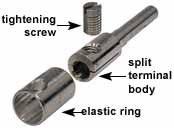Many factors can
contribute to the loosening of terminal screws. These include:
•
Rough handling that frequently occurs in routine
use
• Vibration due to
nearby and/or connected equipment
•
Thermal cycling due to the intermittent current
passage
• The settling and
yielding of multiand conductor that occurs after
tightening
• The normal
yielding of solid copper conductors that results from the pressure of
the
terminal screw
Simple terminal screws, as are used on many competitive
devices, cannot overcome all of these potential problems. In fact, the
unintended loosening of terminal screws is one of the main causes of
failure for standard plugs and receptacles.
 |
|
Meltric has solved this problem with its patented spring-assisted terminals. |
Meltric's unique
design uses a split terminal body that is surrounded by a spring ring to
ensure that a constant force is applied to the conductor. The pressure
generated as the screw is tightened against the conductor causes the split
terminal body to open. In-turn,
this causes the spring ring
surrounding the terminal body to elastically deform into an elliptical
shape.
The natural tendency of the ring to want to spring back to
its original shape maintains the screw pressure against the conductor and
effectively compensates for the loosening effects of conductor yield,
thermal cycling, vibration and rough handling.
In
addition, several other features were also incorporated into the design to
further improve the integrity of the connection:
•
The diameter of the screw head is similar in size
to the threaded hole. This helps ensure that the conductor can be
securely captivated.
• The
split terminal body has an offset design to maximize the number of threads
engaged on the screw.
Together, these features contribute to
making a lasting (but reusable) connection that does not have to be
checked regularly. The user can tighten it and forget it.
|